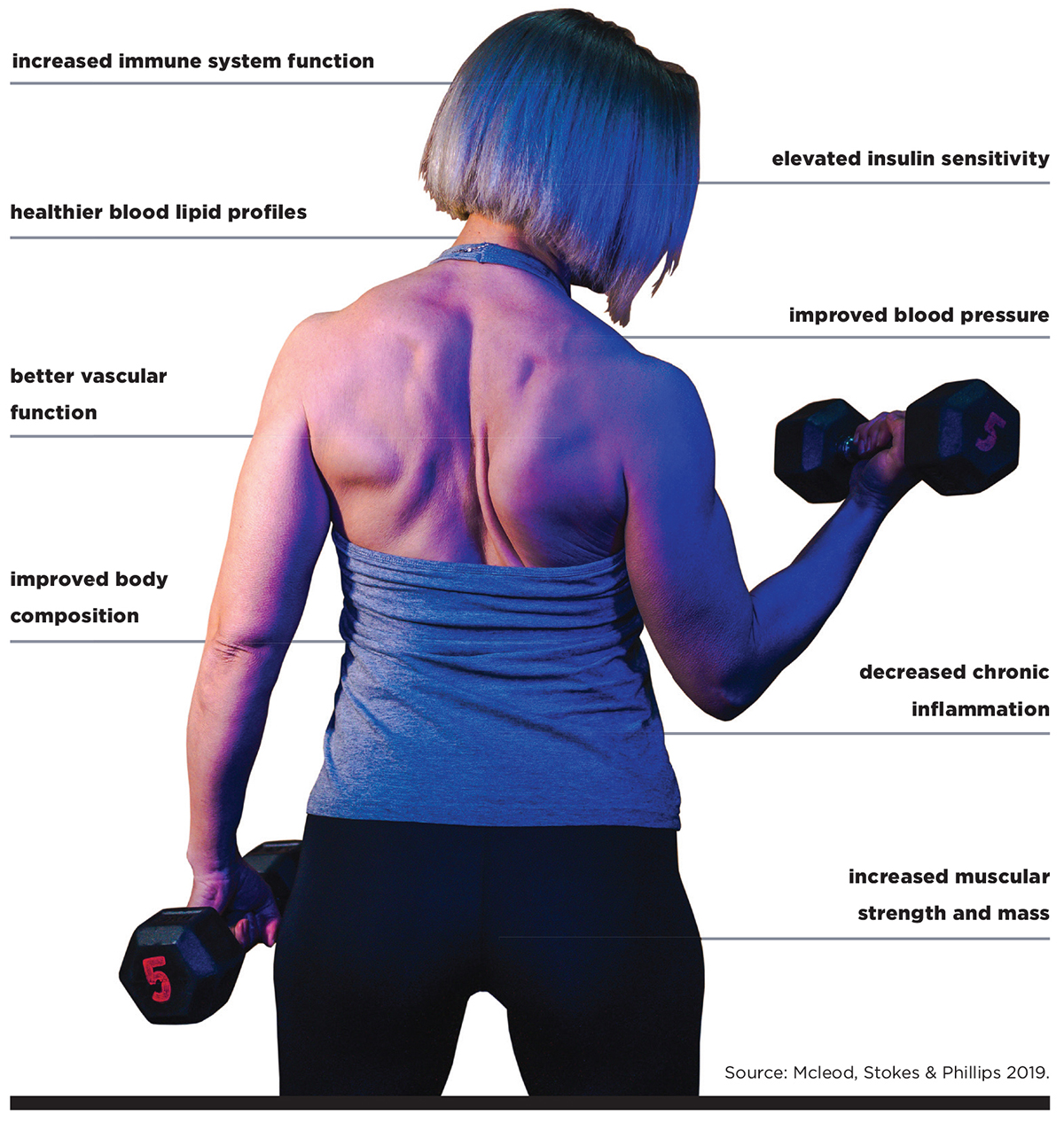Lifting for Muscular Hypertrophy
Strengthen your knowledge of hypertrophy and its definition, significance and training variables.

The benefits of resistance training are incredibly wide-ranging—from reducing chronic disease risk to improving daily function (particularly as we age) to enhancing athletic sport performance and muscular hypertrophy.
As we begin our new journey forward from the pandemic, it is time for the fitness industry to really excel in our efforts to get every person “lifting for life.” This article provides you with the evidence-based tools to help clients make a strong start in increasing muscular hypertrophy.
What is Muscular Hypertrophy?
Muscular hypertrophy is an increase in skeletal muscle size. It’s observed as a sarcoplasmic expansion (i.e., intracellular fluid, sarcoplasmic proteins and glycogen) and/or by an increase in the diameter of the contractile proteins of the muscle. Or, more simply put, hypertrophy is an increase in the thickness of the cross-sectional area of the muscle fiber (Haun et al. 2019).
Techniques to measure hypertrophy—and the whole-body changes in lean mass in body composition—include hydrostatic weighing, dual-energy X-ray absorptiometry (DXA) bioelectrical impedance, and measurement of skinfolds and circumferences. For more direct measurements of hypertrophy, researchers may use magnetic resonance imaging, muscle biopsies and ultrasound imaging.
Understanding the Physiology of Muscular Hypertrophy
Fundamentally, hypertrophy occurs when the rate of muscle protein synthesis (MPS) outpaces the rate of muscle protein breakdown inside of muscle cells for a prolonged period of time (Bamman, Roberts & Adams 2018).
Resistance training is effective for increasing MPS because it imposes metabolic stress, mechanical stimuli and exercise-induced muscle damage. These factors effectively contribute to increased muscle cross-sectional size (Wackerhage et al. 2019).
Wackerhage et al. explain that the stress of muscular contractions stimulate a protein known as the mammalian target of rapamycin complex 1 (mTORc1). When mTORC1 is stimulated, it activates several proteins inside of the muscle cell that initiate an increase in MPS. RT has also been shown to increase the efficiency of ribosomal proteins which positively influence MPS (Bamman, Roberts & Adams 2018). Ribosomes are macro-molecule complexes that activate biological protein synthesis.
See also: Skeletal Muscle Hypertrophy
Why Does Muscular Hypertrophy Matter?
From a functional perspective, hypertrophy is important because it contributes to muscular strength, which is associated with increased mobility, gait speed and independence, while also providing a robust intervention combatting chronic diseases in older clients (Mcleod, Stokes & Phillips 2019) (see graphic below).
From a cardiometabolic health standpoint, the research shows that an increase in muscle mass and strength is associated with improvements in several health-related variables and longevity (Wackerhage et al. 2019).
The following section discusses the essential resistance training variables that help achieve optimal skeletal muscular strength and hypertrophy outcomes.
Fundamental Training Variables for Muscular Hypertrophy
INTENSITY
The external load lifted during RT is referred to as intensity, which is typically quantified as a percentage of 1 repetition maximum (% of 1-RM) or a repetition range. For example, if a client’s 1-RM is 100 pounds, a fitness professional could design a set of 20 reps with 50 lbs, which could be denoted as a 20-RM or 50% of 1-RM.
The effect of intensity on skeletal muscle hypertrophy was addressed in a recent review that concluded that hypertrophic adaptations occur at ≥30% of 1-RM. This proposes a new paradigm shift whereby muscular adaptations can be obtained across a wide spectrum of loading zones. In other words, hypertrophy will occur after training with low-intensity, moderate-intensity and high-intensity external loads, as long as lifters perform their sets close to failure (Schoenfeld et al. 2021).
Schoenfeld et al. suggest from a practical standpoint, a case can be made that moderate loads provide the most efficient means to achieve muscle development. The researchers note that light-load training tends to produce more discomfort and displeasure (from the greater number of repetitions performed) and a higher rating of perceived exertion than training with moderate-to-high loads. Therefore, the moderate loads are likely to be more enjoyable, leading to better exercise adherence.
Uniquely, it is interesting to highlight that fitness pros can successfully design resistance training programs with a variety of external loads and perhaps choose to rotate intensities in a daily, weekly or monthly manner.
PROXIMITY TO FAILURE
Whether RT sets should be performed to failure or not has been a long-standing debate among fitness professionals and researchers. A recent meta-analysis concluded that failure and non-failure training are equally effective for hypertrophy and strength (Grgic et al. 2021). This means that fitness professionals can use phases of both in their training programs. To strike a balance between failure and non-failure training, fitness pros are encouraged to teach their clients how to terminate their sets when they are 1–3 repetitions shy of true muscular failure.
VOLUME
Volume represents the amount of work performed during an RT session, which is typically quantified as the number of sets devoted to a specific muscle group. For example, performing three sets of 10 reps on a knee-extension machine would be three times more volume than performing one set of 10 reps for the same exercise.
As it pertains to set volume, Krieger (2010) reported in a meta-analytical study that multiple sets per exercise were associated with significantly greater increases in muscle size than a single set per exercise. This finding was true regardless of training status of the individuals or training program duration.
When quantified as the number of sets performed for a specific muscle group per week, Schoenfeld, Ogborn & Krieger (2017) reported that hypertrophy occurs in a dose-response manner, as low- (<5 weekly sets), moderate- (5–9 weekly sets) and high-volume (>10 weekly sets) training resulted in 5.4%, 6.6% and 9.8% increases in muscle size, respectively.
For best practice, fitness professionals should use set volume as a means to provide overload and/or tapering. In other words, if a lifter has been performing six weekly sets for their quadriceps, they may
experience significant hypertrophic gains if their set volume is increased to 10 weekly sets. In contrast, a lifter who has been performing 20 weekly sets for their quadriceps may benefit from a tapering block where set volume is reduced to 10 weekly sets.
See also: Resistance Training Volume Is the Key to Muscle Size
FREQUENCY
Resistance training frequency is best described as the number of weekly sessions dedicated to a specific muscle group. When it comes to muscle hypertrophy, Grgic et al. (2018), in their meta-analysis study, summarized that RT frequency plays a secondary role in regard to muscle hypertrophy. The scientists state that the evidence suggests a potential, but slight, advantage with frequencies greater than one day per week. Ultimately, fitness professionals must consider their client’s schedule when determining how many training sessions to book per week.
REST INTERVALS
A rest interval (RI) is defined as the time dedicated to recovering between sets and between exercises during RT sessions. A study by Schoenfeld et al. (2016) reported that 3-minute RIs were more effective than 1-minute RIs for hypertrophy and strength. Thus, by lengthening RIs, fitness professionals allow their client to feel more replenished before beginning subsequent sets, which may result in greater mental focus, total repetitions and muscular fitness output.
If a client is pressed for time, fit pros can balance the benefits of prolonged RIs with training efficiency by prescribing upper/lower-body or push/pull supersets or by executing corrective/mobility exercises during their RIs.
TEMPO
Repetition tempo, which is also referred to as repetition duration, denotes the amount of time dedicated to complete one repetition within a set of RT. In other words, if a lifter lowers the weight for 3 seconds (eccentric phase) and raises the weight for 1 second (concentric phase), the repetition tempo would be 4 seconds. Researchers are typically interested in repetition tempo because it has a direct effect on the time-under-tension (TUT) during a set of exercise. Using the previous example, if a lifter completed five reps or 10 reps with the 4-second tempo, their TUT would be 20 or 40 seconds, respectively.
A review by Lyons & Bagley (2020) concluded that hypertrophy and strength are stimulated by slow (≥14 seconds), moderate (4–13 seconds) or fast (<4 seconds) tempos, and all should be included in RT programs. For practical application, we recommend that fitness pros incorporate a variety of repetition tempos when designing their RT programs for clients.
See also: Variable Resistance Training With Deadshifts and Deadlifts
Major Message Going Forward

Help your clients weight lift for muscular hypertrophy.
Fitness professionals can use this information to design evidence-based, effective resistance training programs to help clients achieve several fitness goals, including increased power, strength, endurance, size and metabolic health. And because those advantages enhance the quality of living, let’s make this a life worth lifting for!
References
Bamman, M.M., Roberts, B.M., & Adams, G.R. 2018. Molecular regulation of exercise-induced muscle fiber hypertrophy. Cold Spring Harbor Perspectives in Medicine, 8, a029751.
Grgic, J., et al. 2018. Effect of resistance training frequency on gains in muscular strength: A systematic review and meta-analysis. Journal of Science and Medicine in Sport, 48 (5), 1207–20.
Grgic, J., et al. 2021. Effects of resistance training performed to repetition failure or non-failure on muscular strength and hypertrophy: A systematic review and meta-analysis. Journal of Sport and Health Science, doi:10.1016/j.jshs.2021.01.007.
Haun, C.T., et al. 2019. Muscle fiber hypertrophy in response to 6 weeks of high-volume resistance training in trained young men is largely attributed to sarcoplasmic hypertrophy. PLOS ONE, 14 (6), e0215267.
Krieger, J.W. 2010. Single vs. multiple sets of resistance exercise for muscle hypertrophy: A meta-analysis. The Journal of Strength and Conditioning Research, 24 (4), 1150–59.
Lyons, A., & Bagley, J.R. 2020. Can resistance training at slow versus traditional repetition speeds induce comparable hypertrophic and strength gains? Strength and Conditioning Journal, 42 (5), 48–56.
Mcleod, J.C., Stokes, T., & Phillips, S.M. 2019. Resistance exercise training as a primary countermeasure to age-related chronic disease. Frontiers in Physiology. doi:10.3389/fphys.2019.00645.
Schoenfeld, B.J., et al. 2016. Longer interset rest periods enhance muscle strength and hypertrophy in resistance-trained men. The Journal of Strength and Conditioning Research, 30 (7), 1805–12.
Schoenfeld, B.J., Ogborn, D., & Krieger, J.W. 2017. Dose-response relationship between weekly resistance training volume and increases in muscle mass: A systematic review and meta-analysis. Journal of Sports Sciences, 35 (11), 1073–82.
Schoenfeld, B.J., et al. 2021. Loading recommendations for muscle strength, hypertrophy and local endurance: A re-examination of the repetition continuum. Sports, 9 (2), 32.
Wackerhage, H., et al. 2019. Stimuli and sensors that initiate skeletal muscle hypertrophy following resistance exercise. Journal of Applied Physiology, 1 (26), 30–43.
Zachary Mang, PhD
Zachary Mang, PhD, is a postdoctoral research associate for the wellness program at the Los Alamos National Lab where he specializes in strength and conditioning for structural firefighters. His research interests include resistance training for hypertrophy, oxidative adaptations to resistance training, and the use of resistance training as a frontline defense to prevent chronic disease.
Jeremy Ducharme
Jeremy Ducharme, is a doctoral student in the exercise science program at the University of New Mexico in Albuquerque, where he works as a teaching and research assistant. His research interests include exercise amongst older adults, and specifically assessing maximal oxygen consumption and adaptations from resistance training in this population.
Len Kravitz, PhD
Len Kravitz, PhD is a professor and program coordinator of exercise science at the University of New Mexico where he recently received the Presidential Award of Distinction and the Outstanding Teacher of the Year award. In addition to being a 2016 inductee into the National Fitness Hall of Fame, Dr. Kravitz was awarded the Fitness Educator of the Year by the American Council on Exercise. Just recently, ACSM honored him with writing the 'Paper of the Year' for the ACSM Health and Fitness Journal.








